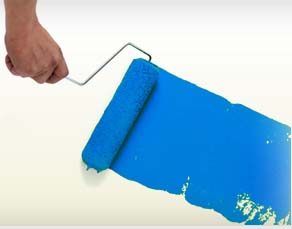|
|||||||
|
Why Prime?
By Jim Parodi
Most people aren’t in the habit of reading the instruction sheet that comes in modern wallpaper rolls. Almost every manufacturer spells out in black and white that in order to hang their product properly the wall must first be primed with a “good quality primer.” If you happen to have any complaint about the wallcovering product later on, it will always come back to the question: “Did you prime the wall with a good quality primer?” That in itself should be a good enough reason to answer the question about whether you should prime or not. But there are better reasons to prime than manufacturers simply saying, “We told you so.” Priming promotes adhesion making it possible to hang on difficult-to-stick-to surfaces like glossy painted walls. Pigmented primers have a white hiding pigment which makes the entire wall uniformly white—very important in today’s world of wallpapers that are not 100% opaque to prevent the old wall color from showing through. Here’s something to consider: Wallpaper doesn’t stick to your wall, it sticks to the paint on your wall. Chances are excellent that the paint on your wall is some form of latex paint. Ordinary interior latex paints are not suitable for wallcovering installations without some sort of priming treatment. Latex paint is commonly in contact with the wet wallpaper paste for a day or longer during the drying process. During this time the latex loses its integrity and softens into a rubbery film. This softening can wreak havoc with the wallpaper installation because every good installation requires a sound, hard surface to hang on. Even worse, a very porous latex can allow paste to travel all the way into the paper facing of your sheetrock making later removal an awful chore. Wallcovering primers, particularly wall protecting primers are specialty products designed specifically to prevent wallpaper paste from softening the latex paint paint on your wall and making the wallpaper become a part of your wall. By preventing this infiltration and isolating the paste right at the surface of your wall, it is ensuring that there will be no ripped up holes in your sheetrock when it comes time to remove the paper. Don’t you mean “sizing?" What’s the big deal about "priming?" Sizing is what your grandmother did when she papered the plastered kitchen or bath walls. Plaster walls are almost indestructible since they are very much like rock hard cement, so Grandma didn’t need wall protection, she just needed to apply sizing—a thinned down wheat paste made from flour— to make the wall less thirsty. This allowed her to hang the paper without the plaster sucking all the paste off from the back of the wallpaper. But even if Grandma’s house was built after 1960, it is almost a sure bet that there isn’t a square inch of plaster in the whole place—almost everything built in the US after that time has a paper-faced gypsum board called drywall or sheetrock. That soft, absorbent paper facing needs more than just a coat of flour paste to protect it from the extended soak time resulting from the application of wet wallpaper. Drywall needs a barrier coating to shield it from the wallpaper paste when the new paper is hung and that barrier is only achieved by priming or sealing the surface. We've hung wallpaper already and they gave us a ‘prep-coat ’at the paint store. Isn’t that a primer? Prep coats are clear, light-duty acrylics. They are best used for installations where you want to be sure the new wallpaper gets a good grip on surfaces that might ordinarily be too glossy or non-porous for the paper to adhere to. Let’s say you move into an older home and the bathroom or kitchen walls have a few coats of high gloss oil paint. A prep coat would stick well to a surface like that and then the wallpaper paste would piggyback on top of the prep coat film for adhesion. It is important to remember that prep-coats adhere well to things like glass, formica, plastic paneling, and glossy non porous paints but don’t guarantee wall protection when used on a regular latex painted wall. They are slightly better than sizing ...paste sizing offers almost no wall protection. THE WALL PROTECTING PRIMERS: Universal Pigmented Acrylics, Alkyd Primers*, Drywall Repair Clears. These three types of primers are what the wallpaper manufacturers are talking about when they recommend a “good quality primer” on the instruction sheet. Not only do they form a hard crust on the soft drywallpaper but they also block out and seal out anything that may come through the existing paint to damage your new paper—for example, old brown paste hiding in pores from earlier wallpaper installations can leach into delicate wallpapers and stain them. Wall protecting primers can make the difference between an excellent installation and a seam-popping, drywall ripping fiasco. They insure an excellent installation and that means the wallpaper is:
When a Pro Primes for a Pro Installation: Professional paperhangers should wear T-shirts that say, “Please Don’t Try This Yourself at Home.” In order to hang wallpapers in rooms that are imperfect, or hang papers that are themselves imperfect, it frequently becomes necessary to use professional hanging techniques where good wall protection is essential. Repositioning several sheets at a time may be necessary to adjust patterns for optimal “straightness” in rooms that aren’t really straight. Specialized double-cutting techniques allow the pro to inlay borders at the ceiling or chair-rail and achieve complicated joinery in archways—all of which would be impossible without a professional-grade wall protecting primer on the wall surface. *Alkyd primers must be top coated with an acrylic prep-coat Note: Drywall Repairs Clears have no white pigment to hide the old color of the wall—not usually a problem unless the wall was a dark color. |



